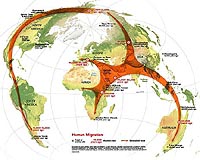| . |  |
. |
Tempe AZ (SPX) Jul 30, 2009 Genetic evidence is revealing that human populations began to expand in size in Africa during the Late Stone Age approximately 40,000 years ago. A research team led by Michael F. Hammer (Arizona Research Laboratory's Division of Biotechnology at the University of Arizona) found that sub-Saharan populations increased in size well before the development of agriculture. This research supports the hypothesis that population growth played a significant role in the evolution of human cultures in the Late Pleistocene. The team's findings are published in the online peer reviewed journal PLoS ONE on July 29. Reconstructions of the timing and magnitude of changes in human population size are important for understanding the evolution of our species. There has been a longstanding disagreement whether humans began to increase in number as a result of innovative technologies and/or behaviors formulated by hunter-gatherer groups in the Late Pleistocene, or with the advent of agriculture in the Neolithic. Hammer's research integrates empirical genetics with discoveries in paleontology and archeology to help provide answers to interdisciplinary questions about which kinds of innovations led to the evolutionary success of humankind. Hammer's UA team, together with their collaborator from the University of California San Francisco's Institute for Human Genetics and Department of Epidemiology and Biostatistics, surveyed the genetic material of ~184 individuals from seven human populations and used a computational approach to simulate the evolution of genetic lineages over time. The researchers found that both hunter-gathers and food-producing groups best fit models with approximately ten-fold population growth beginning well before the origin of agriculture. For the first time ever, Hammer's team was able to investigate the timing of human population expansion by applying sophisticated inferential statistics to a large multilocus autosomal data set re-sequenced in multiple contemporary sub-Saharan African populations. The team's finely executed experimental design and use of supercomputing power enabled them to determine that this expansion in population size likely began at the start of the Late Stone Age-a period in prehistory that shows an intensification of archeological sites, an increased abundance of blade-based lithic technologies, and enhanced long-distance exchange. The next step in the project is to gather more data by testing more populations and additional parts of the genome. Share This Article With Planet Earth
Related Links Arizona Research Laboratory's Division of Biotechnology All About Human Beings and How We Got To Be Here
 Australia Discovered By The Southern Route
Australia Discovered By The Southern RouteKolkata, India (SPX) Jul 22, 2009 Genetic research indicates that Australian Aborigines initially arrived via south Asia. Researchers writing in the open access journal BMC Evolutionary Biology have found telltale mutations in modern-day Indian populations that are exclusively shared by Aborigines. Dr Raghavendra Rao worked with a team of researchers from the Anthropological Survey of India to sequence 966 complete ... read more |
|
| The content herein, unless otherwise known to be public domain, are Copyright 1995-2009 - SpaceDaily. AFP and UPI Wire Stories are copyright Agence France-Presse and United Press International. ESA Portal Reports are copyright European Space Agency. All NASA sourced material is public domain. Additional copyrights may apply in whole or part to other bona fide parties. Advertising does not imply endorsement,agreement or approval of any opinions, statements or information provided by SpaceDaily on any Web page published or hosted by SpaceDaily. Privacy Statement |